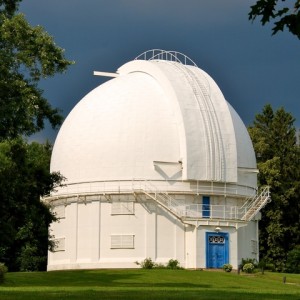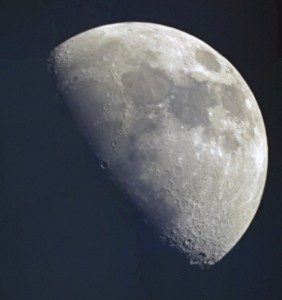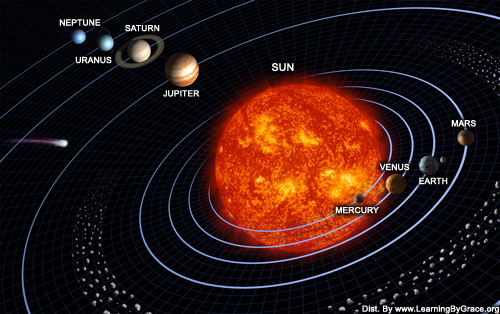Here are some photos from our visit to the Observatory on April 19th. Enjoy.
Photos by John Goodyear.
Kids looking up!
Here are some photos from our visit to the Observatory on April 19th. Enjoy.
Photos by John Goodyear.
A caravan of cars traveled from Huron to the DDO this past Thursday evening. We arrived shortly after 7pm and were greeted by Paul Mortfield and Michelle Johns. We assembled in the lecture hall inside the administrative building for a lecture by Paul on the sun and space weather.
Paul gave a dynamic lecture about the sun, solar flares, coronal mass ejections and more. The lecture was filled with animations and video clips revealing the activity taking place constantly on our sun. We were reminded that looking directly at the sun can create the dangerous effect called FFE (French Fried Eyeballs).
Here are some facts we learned in Paul’s lecture:
You can explore some of the threads of research described in the lecture on the NASA’s Heliophysics, SOHO Mission, and Solar Dynamics web pages.
After the lecture, we walked up the hill to the big dome and spent some time learning about the largest telescope in Canada! Members of the club got to move the telescope. Unfortunately, we had cloudy skies….
What did you like best about the visit to the DDO? Please feel free to use the comments field below to share your experience.
In April, the club plans to organize a visit to the David Dunlap Observatory. With the telescope housed there, Toronto astronomer Tom Bolton confirmed the existence of the first black hole, called Cygnus X-1! It’s gonna be awesome.
Please RSVP by clicking here and filling out the form.

(Photograph by John Goodyear.)
Professor John Percy discusses the history of the David Dunlap Observatory.
Professor Peter Martin discusses the creation of the Dunlap Institute.
Dunlap Institute Director James Graham discusses the mission of the Dunlap Institute.
The moon never ceases to inspire and impress. This photo was taken on Saturday Mar. 31, 2012, from my backyard in mid-town Toronto. Enjoy. 

SpEC binary black hole simulation – Image Credit: Harald Pfeiffer (CITA)
April 5th, 2012, 9:10pm
Speaker: Ilana MacDonald
Location: MP 102, 60 St. George street
Sign up for the Planetarium Show!
The force of gravity is something that each and every one of us experiences all the time. It’s what keeps us from flying into space off the surface of the earth, and what keeps the planets in orbit around the sun. In this talk, we shall explore the concept of gravity, starting with humanity’s earliest theories about how the this force works and ending with my current research on the ripples in space-time caused by inspiralling binary black holes. We will discuss the theories of the ancient Greek philosopher Aristotle, the renaissance scientists Copernicus, Galileo, and Kepler, and the revolutionary physicists Newton and Einstein. We will see that the evolution of the concept of gravity is closely tied with the history of science and astronomy.

Ilana MacDonald is a PhD candidate in the fourth year of her doctoral studies in the Department of Astronomy and Astrophysics at the University of Toronto. With her supervisor Prof. Harald Pfeiffer of CITA, she studies the gravitational waves, that is, ripples in space-time, given off by binary black holes. She is also very involved in Astronomy public outreach at UofT, helping organize public lectures, and giving planetarium shows to the public. In her spare time, she enjoys knitting and riding her e-bike all around the city (though not at the same time).
(Content taken from http://www1.astro.utoronto.ca/~gasa/public_talk/iWeb/Entries/2012/4/gravity.php)
What did you learn? What was your favorite part? How could it have been better? Please feel free to share your comments and suggestions using the comment field below! We had 264 people respond to the RSVP request. Thanks to all the volunteers, club members, special guests, Huron staff and attendees!
Professor Percy’s lecture slides are available here: 2012-03-01_John_Percy_Huron
Professor Wu’s lecture slides are available here: 2012-03-01_Yanqin_Wu_Huron
Venus, Jupiter and the Moon will converge tonight and tomorrow night (Saturday, Feb. 25 and Sunday, Feb 26) for a beautiful alignment. Look southwest, between 6:00 pm and 8:00 pm.
Check these links to the Toronto Star, and SpaceWeather.com for more information.
Toronto Star: Venus-Jupiter-Crescent Moon align for triple threat for star gazers
Award winning teacher and professional astronomer John Percy will deliver a brief lecture at the Astronomy Club’s Family night on 1 March 2012 entitled:
How Stars Die
Abstract: Stars are distant suns. Unlike planets, they produce energy. They do this by nuclear fusion; they fuse hydrogen into helium in their cores. But after billions of years, the nuclear fuel runs out. In stars like the sun, the star first expands, engulfing any planets close to it, and the outer layers drift off into space. The core shrinks until it is a million times denser than water. It becomes a white dwarf. Large, rare stars explode at the end of their lives, as supernovas, and their cores collapse until they are a trillion times denser than water. They become neutron stars. Very large, rare stars explode and their cores collapse until they are so dense that nothing can escape their gravity — not even light. They become black holes.
Professor Percy’s lecture slides are available here: 2012-03-01_John_Percy_Huron
Huron parent and professional astronomer Yanqin Wu will deliver a talk at the Astronomy Club’s Family Night on 1 March entitled: 
Twinkling stars, how many planets do you have?
Abstract:
On the last count, the Sun has 8 planets, including planets Earth, Jupiter and Saturn. But when we look up at the sky and see those twinkling stars, we can’t help wondering how many planets do each of them have. Are they lonesome stars drifting in space without a family of planets? or are they happily surrounded by planets just like our sun is?
Over the last few years, astronomers are finally discovering the answer to this question. And the answer is far more interesting than we can imagine.
Professor Wu’s lecture slides are available here: 2012-03-01_Yanqin_Wu_Huron
